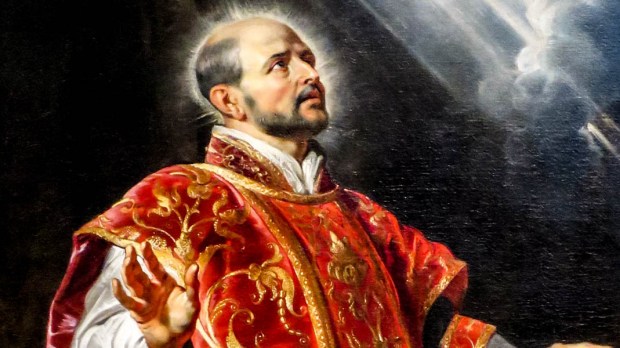Contemplating the Baby in the manger is an invitation to prayer, but it’s easy to get stuck in sweet sentiments. St. Ignatius’ meditation on the Incarnation can be a way to go deeper.
This meditation, drawn from the Ignatian Spiritual Exercises, is true to Ignatius’ imaginative-contemplative style of prayer. It engages mind, heart, and imagination, connects us into the Gospel story and leaves plenty of room for the Scriptures to become a living and active part of our own stories.
In each meditation, St. Ignatius encourages us to ask the Lord for a specific grace. The grace associated with the meditation on the Incarnation is “(…) to ask for interior knowledge of the Lord, who for me has become man, that I may more love and follow him.”
Starting above
The meditation begins on the cosmic level, as we are invited to imagine the three Persons of the Trinity up in heaven, looking down on humanity.
Think of what God sees when he looks down on our world. He sees individuals and families, old and young, from all different nationalities, cultures and religions. He sees birth and death, war and peace, poverty and wealth. He sees the global crises, and he sees individual lives. He sees you.
The Lord knows what you think about when you first wake up in the morning. He knows what parts of life satisfy you and what leaves you longing for more or feeling disillusioned. He sees your failures, but not in the same way you see them; he views all things in light of your journey, as a way for you to draw closer to him and lean upon him more.
“Come to me, all you who labor and are overburdened, and I will give you rest, for my yoke is easy, and my burden light.”
God sees the suffering you go through. He knows the moments you want to cry out, “Why, God?”, the moments you falter a bit and wonder if he truly sees and cares. He feels every movement of your heart: fear, grief, tension, hope …
The Lord knows the faults and failings we can’t seem to shake off, no matter how hard we try, and he knows our good intentions. Life, on the cosmic and particular levels, is a beautiful mess, full of struggle and progress, respite and challenge.
Think of your experience of life, and of God, right now. What does it look like?
God was not left unmoved by the scene he witnessed from above 2,000 years ago, nor is he left unmoved as he gazes upon each one of us today. God could have chosen to simply end the mess.
God’s response
Instead, knowing that in the mess we can grow, learn and exercise our own freedom, he chooses to enter the mess and walk alongside of us, bringing meaning to our struggles and using all circumstances, to draw us to himself.
This moment of the meditation, the point at which God decided to come among us through the Incarnation, brings us to the heart of Ignatian spirituality: finding God in all things.
Gaze at Mary
Mary sets the best example of how to find God in all things, and the final point of Ignatius’ meditation on the Incarnation invites us to gaze upon her, a young girl from a small town, living in a simple dwelling.
Allow your imagination to place yourself in the scene. How do you picture Mary? Is she working with her hands, or doing housework? What is she thinking and praying about? She knew the promises God had made about a Savior. She knew the prophecies. She knows how much the world needed God.
Mary looks up and is surprised to see a figure standing there: the Angel Gabriel. Mary listened as the angel told her not to be afraid, and prophesied that she would give birth to the Messiah. She asked how this could come to pass, and gave her free consent: “Behold, I am the handmaid of the Lord. May it be done to me according to your word.”
Stay with Mary for a few moments after the Angel leaves. What do you want to say to her? What has the Lord been revealing to you during this time? How do you feel called to respond?
To do this meditation, allow the Lord to speak to your mind and heart as you go through the theme. Pause, and linger on the ideas that most resonate with you. Make a mental note of any ideas you want to go back to later. This is a time, above all, to recognize where God is present in your life, and invite him to enter into your heart even more fully during the Christmas season.

Read more:
What’s the difference between meditation and contemplation?

